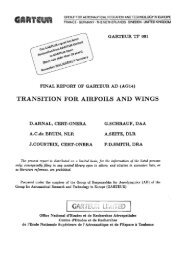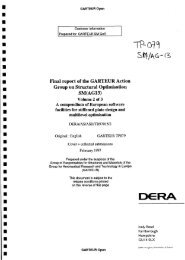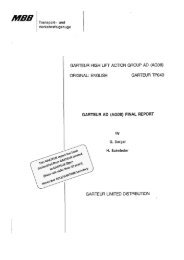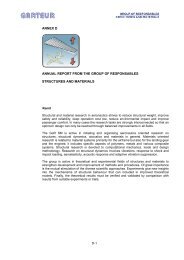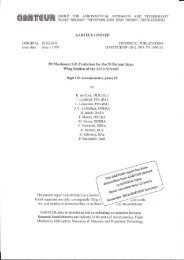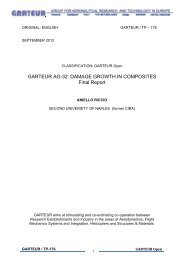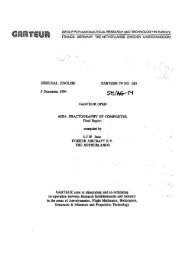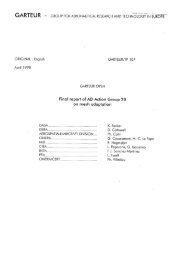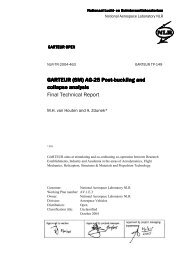Cadmium Substitution - garteur
Cadmium Substitution - garteur
Cadmium Substitution - garteur
Create successful ePaper yourself
Turn your PDF publications into a flip-book with our unique Google optimized e-Paper software.
GARTEUR LIMITED<br />
The results of the neutral salt fog tests undertaken by DERA are given in figure 4. The<br />
data show that only the two commercial metallic ceramic coatings, SermeTel and Deltatone<br />
out performed cadmium when tested in the as plated condition. In every case<br />
carrying out post plating treatments such as passivating considerably improved the<br />
performance of the coating but only the SermeTel 984 coating with SermeTel 985 gave a<br />
higher time to first red rust than passivated cadmium plating.<br />
Neutral salt spray tests were conducted by two other laboratories Shorts and Fokker on<br />
a limited number of coatings. Although the actual times to red rust for undamaged panels<br />
varied considerably between the three laboratories, there was general agreement<br />
regarding the relative performances of the coatings.<br />
As plated<br />
SermeTel 984 > ED cadmium >ED zinc – nickel ˜ ED zinc – cobalt – iron<br />
Plated + post plating treatment<br />
SermeTel 984 + 985 > Pass. ED cadmium > Pass. ED Zn-Ni ˜ Pass. ED Zn-Co-Fe<br />
As indicated in section 4.1, the thicknesses of the different coatings studied varied<br />
considerably. The thicknesses were specified by the various coating suppliers to give the<br />
desired combinations of corrosion protection, adhesion, frictional properties etc. The<br />
SermeTel 984 coating for example has a mean thickness of about 40μm compared with<br />
PVD aluminium, which was found to be 18 – 22μm thick. Previously published work has<br />
looked at the dependence of time to red rust on coating thickness [2]. This shows that for<br />
relatively thin coatings an almost linear relationship exits. However for thicker coatings,<br />
small increases in coating thickness have a large effect on the time to red rust.<br />
In the present study, the results given in figure 4 have been compared taking into<br />
account the differences in coating thicknesses. A “normalised” time to red rust was<br />
calculated for each coating system by dividing the time to red rust by the coating<br />
thickness. The values obtained are compared in figure 5.<br />
From figure 5 it is apparent that whilst the as plated UMS Al-Mg, Delta-tone and<br />
SermeTel coatings out perform cadmium plating in the neutral salt fog tests, the<br />
passivated cadmium plating gives the highest level of corrosion protection.<br />
In the present programme two additional accelerated corrosion tests were employed to<br />
evaluate the coatings. These were<br />
• Exposure to intermittent acidified salt spray (MASTMAASIS test)<br />
• Exposure to 100% humidity<br />
MASTMAASIS testing was undertaken by DERA and NLR whilst exposure to 100%<br />
humidity was investigated by Fokker.<br />
The main observations from the MASTMAASIS tests are summarised in table 6. Whilst<br />
good agreement was obtained for tests conducted on as plated panels some differences<br />
were found on tests carried out on passivated panels.<br />
Humidity tests were conducted on the ED zinc alloy coatings and on the two metal –<br />
ceramic coatings. Testing was continued for 2000 hours and at this point only the Deltatone<br />
showed evidence of rusting.<br />
B) Outdoor exposure trials<br />
GARTEUR SM/AG17 TP128 Page 9




